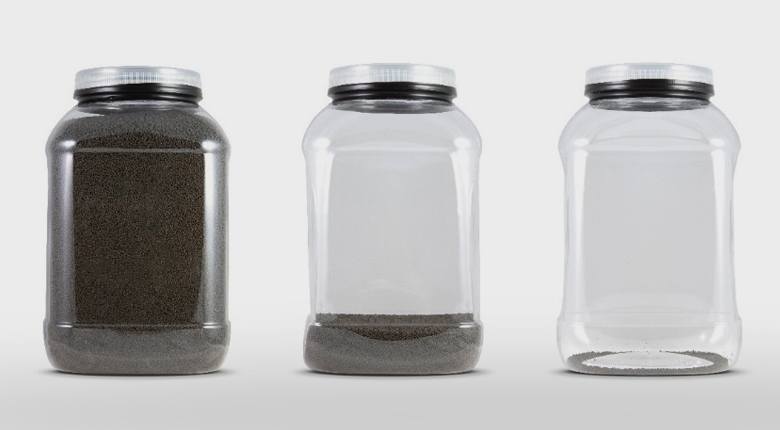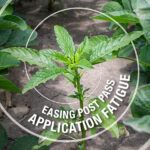Control Weed Seed for Clear Fields
Manage weeds before they take hold by using full-labeled herbicide application rates.

You wouldn’t fill your gas tank half full and expect to go the same number of miles as a full tank. The same applies to your herbicide program. Using the full-labeled rate is one of the most important factors towards having a successful weed control outcome. This approach extends residual control helping to prevent weeds from emerging late and going to seed.
Understand the Weed Seed Bank
Every season, you plant your crop into soil that contains weed seed deposits from weeds left uncontrolled in past seasons or carried in by equipment, animals or the environment. If you didn’t achieve effective weed control in past seasons, your weed seed bank will contain extra weed seeds just waiting to emerge and compete with your crop.
Waterhemp seeds can remain viable in the soil for several years, with studies showing that 12% of seeds can persist in the soil, even after four years of burial.1 Other weed species can survive even longer in the soil seed bank, which is why it’s important to know which weeds you’re battling in each of your fields.
Manage Your Weed Seed Bank
Broad-spectrum, preemergence residual herbicides and residual herbicide programs are available to help control weeds before they emerge and have a chance to produce weed seed. However, these herbicides will only perform at their maximum level — and give you the most value — if they are used at the full-labeled rate designed to deliver a successful weed control outcome. Before a second flush of weeds can emerge, follow up with a post-emergence residual herbicide to help achieve overlapping, season-long residual weed control.
“Using a full rate of preemergence residual herbicides like Acuron® or Storen® for corn or Tendovo® for soybeans will give you greater consistency, so you can get more weed control, more often,” says Mark Kitt, technical product lead of corn herbicides at Syngenta.
The Value of Using Herbicides at the Full-labeled Rate

This demonstration assumes there is a population of 100 waterhemp plants per acre, with each plant producing 250,000 seeds.2
These three jars contain varying amounts of waterhemp seeds, and you can see that herbicide application rate affects the number of weed survivors and the weeds seeds they can produce, according to Kitt.
- The jar on the left shows what can happen if you don’t use any herbicide to control waterhemp. Untreated, waterhemp has a survival rate of 100%. This uncontrolled waterhemp can produce up to 25 million waterhemp seeds per acre.
- The middle jar shows what can happen if you use a herbicide at a reduced rate. Where Acuron was applied at a reduced rate of 1.67 quarts per acre, 13% of waterhemp survived with the potential to produce up to 3.25 million weed seeds per acre.*
- The last jar shows what can happen if you use a herbicide at a full-labeled rate. Where Acuron was applied at a full rate of 2.5-3.0 quarts per acre, the waterhemp survival rate was less than one percent, reducing potential weed seed production to only 37,500 seeds per acre.*
* If an overlapping application was not made to manage the survivors.
It’s important to remember that applying full-labeled rates supports sound herbicide resistance management practices. Then, you are able to more effectively control weeds by controlling the weed seed, and not just the emerged weed.
Additional Benefits of Full-labeled Herbicide Rates
Yield Protection
Using a preemergence residual herbicide at a full-labeled rate can also boost yield potential. If the emerging crop doesn’t have to compete with weeds for key nutrients like water, nitrogen, phosphorus and potassium needed for crop growth, more yield potential will be protected.
- Water: At a Syngenta Grow More™ Experience site in York, Nebraska, our agronomists found that in three days, three-inch weeds can remove one inch of water from the soil.3
- Macronutrients: Weeds as little as 2-4″ can consume 13.4 lbs. of nitrogen, 0.85 lbs. of phosphorus and 16.8 lbs. of potassium.4
Healthy Weed-free Corn Can Focus on Growth and Grain Fill
- Acuron is the only corn herbicide shown in replicated trials to outyield competitors by 5-15 bu/A.5
- Tendovo can help increase soybean yield potential by 4-5 bu/A compared to competitive herbicide brands.6
Residual Activity
Using a full-labeled herbicide rate also means you can expect to get the complete duration of a product’s residual activity. While many herbicides last four to six weeks, Storen corn herbicide, when applied at its full-labeled rate of 2.1 – 2.4 qt/A, has been proven to deliver residual control that can last up to three weeks longer than other leading corn herbicides.7
Resistance Management
“It’s important to remember that applying full-labeled rates supports sound herbicide resistance management practices,” Kitt says. “Then, you are able to more effectively control weeds by controlling the weed seed, and not just the emerged weed.”
1 Data Source: 2007 University of Missouri Extension.
2 Data Source: Head-to-head trial comparisons from the Global Data Base: DE-3; GA-3; GA-4; IA-07; IA-16; IA-24; IL-10; IL-13; IL-21; IL-22; IL-26; IL-27-[HPPD-R]; LA-01; MO-03; MO-05; MS-03; NC-2; NE-02; NE-10-[HPPD-R]; NE-17-[HPPD-R]; Ne-20; NE-21; NE-22; OK-3; OK-3; TN-11; TX-13; TX-15.
3 Data Source: 2006 Syngenta trials: York, NE.
4 Weed Nutrient Uptake Source: Approximately 20 Syngenta Learning Center Research locations between 2006-2008. Nutrients measured from samples taken from weeds 1-2” and 2-4” in height. Analysis completed by Midwest Labs, Omaha, NE. Period from weed emergence to removal at 1-2” in height was 10 days and 2-4” in height was 20 days.
5 Acuron yield advantage range based on 2016 Syngenta and University trials comparing Acuron to Corvus®, Resicore®, SureStart® II and Verdict® applied preemergence at full label rates.
6 2020 – University Trials – HSM050ABC4 – 2020US – IL, AR, MI, OH, MO.
7 Storen length-of-control advantage based on 2022 Syngenta and university replicated trials comparing Storen to Resicore® and TriVolt®. Data Source: 2022; HBI008A4-2022US.
4 Min Read
- Some weed seeds can survive for years before emerging.
- Use a full-labeled rate of a preemergence residual herbicide to maximize weed control and minimize weed seeds for years to come.
- Acuron®, Storen® and Tendovo® herbicides, when used at their full-labeled application rates, can help keep your rows clean, manage your weed seed bank and maximize yield potential.
More Articles About Field Insights
RECOMMENDED FOR YOU
4 Min Read


















